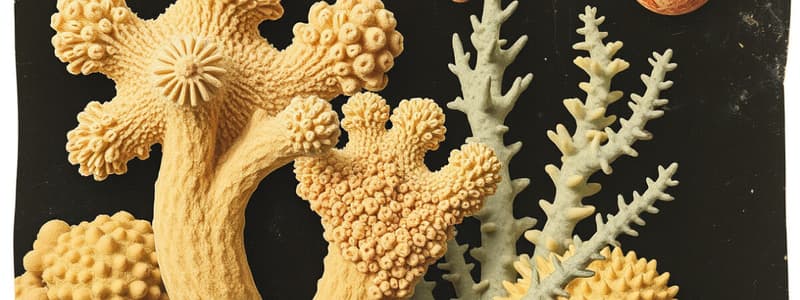Podcast
Questions and Answers
What is visible when you look at a sponge?
What is visible when you look at a sponge?
Its skeleton; all cells are gone.
What are metazoans?
What are metazoans?
Multicelled animals.
What are choanoflagellates?
What are choanoflagellates?
Protists that are the closest living relatives of animals.
What does the colonial flagellate hypothesis state?
What does the colonial flagellate hypothesis state?
What are the characteristics of sponge evolution?
What are the characteristics of sponge evolution?
What is the sponge growth form like?
What is the sponge growth form like?
What are the four classes of sponges?
What are the four classes of sponges?
What characteristics is sponge classification based on?
What characteristics is sponge classification based on?
What are spicules?
What are spicules?
What is the function of sclerocyte cells?
What is the function of sclerocyte cells?
What is spongin?
What is spongin?
How do sponges feed?
How do sponges feed?
What is the order of water movement through the sponge's canal system?
What is the order of water movement through the sponge's canal system?
What are dermal ostia?
What are dermal ostia?
What are choanocytes?
What are choanocytes?
What is the osculum?
What is the osculum?
What is the spongocoel?
What is the spongocoel?
What is characteristic of asconoid sponges?
What is characteristic of asconoid sponges?
What is the water path in asconoid sponges?
What is the water path in asconoid sponges?
What are syconoid sponges?
What are syconoid sponges?
What is the water path in syconoid sponges?
What is the water path in syconoid sponges?
What advantages does the folding of the body wall give syconoid sponges?
What advantages does the folding of the body wall give syconoid sponges?
What is the leuconoid canal system?
What is the leuconoid canal system?
What advantages does the leuconoid canal system provide over other systems?
What advantages does the leuconoid canal system provide over other systems?
How do adult sponges colonize new habitats despite being sessile?
How do adult sponges colonize new habitats despite being sessile?
How might changes in sponge population affect other organisms in coral reefs?
How might changes in sponge population affect other organisms in coral reefs?
What is an argument against the colonial flagellate hypothesis?
What is an argument against the colonial flagellate hypothesis?
How would an abnormally small prosopyle and large apopyle affect a syconoid sponge's filtering ability?
How would an abnormally small prosopyle and large apopyle affect a syconoid sponge's filtering ability?
Describe two features that Phylum Porifera and Phylum Placozoa have in common.
Describe two features that Phylum Porifera and Phylum Placozoa have in common.
Flashcards are hidden until you start studying
Study Notes
Phylum Porifera: Sponges Overview
- Sponges are part of Phylum Porifera, characterized by their simplicity and lack of true tissues.
- They resemble choanoflagellates, indicating evolutionary connections.
- Adult sponges are sessile, relying on gametes and larvae for reproduction and colonization.
Sponge Structure and Composition
- Sponge skeletons consist of support structures called spicules, secreted by sclerocyte cells.
- Spicules can be siliceous (made of silica) or calcareous (made of calcium carbonate).
- Spongin is a fibrous protein that contributes to the sponge's skeletal framework.
Sponge Forms and Classes
- Sponge bodyforms vary in complexity, including asconoid, syconoid, and leuconoid structures.
- Four main classes of sponges: Homoscieromorpha, Calcarea, Demospongiae, Hexactinellida.
- Sponge classification is based on spicule structure, presence of spongin, and canal system type.
Canal Systems
- All sponges use canal systems to filter water for feeding: dermal ostia > choanocytes > osculum.
- Asconoid sponges have a simple vase-like structure with a single osculum; they have choanocytes lining the spongocoel.
- Syconoid sponges have folded body walls creating incurrent and radial canals for better water filtration.
- Leuconoid sponges are the most complex, with multiple flagellated chambers leading to excurrent canals.
Water Movement in Sponges
- Asconoid water path: dermal ostia > choanocytes > spongocoel > osculum.
- Syconoid water path: dermal ostia > incurrent canal > prosopyles > radial canals > apopyles > spongocoel > osculum.
- Leuconoid water path: dermal ostia > incurrent canal > prosopyles > flagellated chambers > excurrent canals > osculum.
Habitat and Ecosystem Impact
- Sponges provide essential habitats for various marine species and can affect community dynamics through their population changes.
- A decrease in sponge populations can lead to reduced shelter for smaller organisms and loss of food resources for sponge-eating fish.
Evolutionary Connection
- Choanoflagellates are considered closely related to sponges, supporting the colonial flagellate hypothesis that suggests an ancestral form resembling a colony of flagellated cells.
Abnormal Structures and Their Effects
- Abnormalities in sponge structures, such as small prosopyles or large apopyles, can reduce oxygen intake and filter efficiency, impacting feeding capabilities.
Similarities Between Porifera and Placozoa
- Both phyla exhibit characteristics like metazoan status, asymmetry, and amorphous shapes, as well as infoldings in their epithelial structures.
Studying That Suits You
Use AI to generate personalized quizzes and flashcards to suit your learning preferences.




